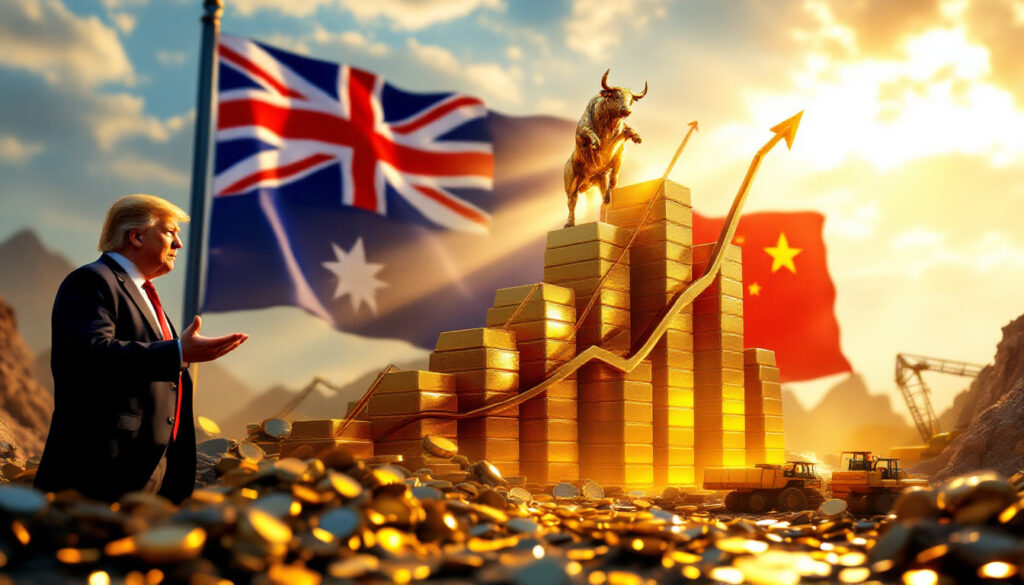## How Does the US Tariff Pause Impact the Australian Securities Exchange (ASX)?
The recent 90-day tariff pause announced by US President Donald Trump, excluding China, triggered a historic rally in the Australian Securities Exchange (ASX). This dramatic move has reinvigorated sentiment among investors, particularly those focused on the US tariff pause and ASX. Indeed, market participants are closely watching how such trade policies affect share prices and commodity values.
The announcement has also highlighted the potential for significant market swings, prompting reconsiderations of risk exposure and strategic positioning. Analysts point to the current environment as one where fundamentals and sentiment now intersect, making the ongoing discussion about the US tariff pause and ASX even more critical for investors.
## What Immediate Effects Has the Tariff Pause Had on the ASX?
### Record One-Day Rally for ASX200
The ASX200 Futures surged by an impressive 6.72% (497 points) prior to market open on April 10, 2025. When trading commenced, the index soared 4.99% (+368.10 points) and reached 7,743.1 points.
Furthermore, a live market update revealed these movements in real time. Consequently, investors have become more attentive to the ripple effects of such rapid changes.
This rally marked the ASX’s strongest performance since March 2020. The upward momentum effectively erased recent losses from preceding sessions and reduced the annual decline. Additionally, the renewed vigour in markets has prompted discussions regarding longer-term recovery strategies.
### Sector-Wide Gains in ASX
All 11 sectors of the ASX200 confirmed positive movement. In particular, the materials and financial sectors led the recovery wave.
The materials sector recorded a notable gain of 6.48%, and the financial sector followed closely with 5.56%. In addition, utilities and energy sectors gained momentum, albeit to a more modest extent.
This broad-based recovery underscores how trade policy shocks can ripple through various industries while offering potential opportunities for those ready to adapt. Moreover, such sector performance has deep implications for strategic asset allocations, fostering a renewed debate on risk management.
## How Have Commodities Responded to the US Tariff Pause?
### Commodities Market Overview
The ANZ China Commodity Index experienced an increase of 0.3%, driven by modest gains in precious and industrial metals. Financial analysts often rely on global commodities insights to assess market trends in shifting environments.
As uncertainty looms, investors are balancing caution with opportunistic buying.
For instance, commodities remain a cornerstone for diversifying portfolios during turbulent times. Analysts note that while the equity rally boosted sentiment, commodities continue to be valued for their safe-haven appeal. This scenario invites thoughtful consideration regarding the interplay between equities and tangible assets.
### Specific Commodities' Performance
- Gold: Increased by +3.6% to US$3,086 (~AUD$5,038) per ounce. For instance, alternative investments such as gold etf strategies enhance a diversified portfolio.
- Silver: Rose by +4.2% to approximately US$31 per ounce, outpacing gold on a percentage basis.
- Copper: Escalated by +8.2%, reaching US$9,677 per tonne—a spike that underscores renewed confidence in industrial demands. It is also important to note that copper market strategies may help investors manage risks.
These impressive gains in commodity prices illustrate the market’s reaction to easing trade frictions. However, experts urge caution due to potential reversals should geopolitical tensions intensify again.
## Which Major ASX Resource Stocks Experienced the Largest Gains?
### Top Performing ASX Resource Companies
The materials sector’s surge was led by several key resource stocks, including Sandfire Resources, IGO Limited, and Mineral Resources.
Investors new to the sector may refer to our mining stocks guide for comprehensive insights into these dynamic companies.
Below is a summary of the leading performers:
- Sandfire Resources (SFR): +14.85%, trading at AUD$9.36
- IGO Limited (IGO): +14.1%, with a share price of AUD$3.56
- Mineral Resources (MIN): +13.54%, valued at AUD$16.35
These companies significantly propelled the market rally, particularly in the materials sector where perceptions of value and stability remain paramount. Moreover, the disparity between energy and materials stocks highlights differing levels of exposure to trade policy outcomes.
Financial experts are advising that while momentum is strong, maintaining vigilance is critical. The market’s reaction should be viewed with an understanding of the underlying shifts that may reverse such gains promptly.
## What Does the US-China Tariff Escalation Mean for Investors?
### Understanding the Ongoing Risks Despite Positive Sentiment
The tariff dynamics remain contentious in a challenging global landscape. US-China tensions continue as tariffs between the two economic giants remain at record levels.
With the US maintaining a 125% tariff rate on Chinese goods and China retaliating with 84%, risks are compounded for global supply chains.
At this juncture, the impact of the US tariff pause and ASX is evident. Investors face ongoing uncertainty, as these policy actions hold significant potential to disrupt market stability. Analysts warn that such geopolitical friction may have prolonged effects on investor confidence.
### Hedging Risks: Investor Strategies
To navigate current market conditions, financial experts suggest several prudent strategies:
- Diversify portfolios across sectors less affected by US-China trade tensions.
- Increase allocations to companies with customer bases extending beyond China.
- Employ tactical options and futures to hedge against sudden commodity price shifts.
- Invest in critical minerals like lithium and rare earths as potential winners in a restructured supply chain.
In addition, investors should consider differentiating between long-term investments and short-term speculation. It is prudent to review investing vs speculating approaches in order to reduce undue risks. This calculated methodology is vital during periods of pronounced market volatility.
## Frequently Asked Questions (FAQs)
### What Does a Tariff Pause Mean?
A tariff pause temporarily suspends planned increases in import duties on traded goods. In this instance, the US has halted tariffs exceeding 10% for 90 days.
This pause does not cancel existing tariffs; however, it provides breathing space for global markets amid ongoing trade discussions.
### Why Did President Trump Exclude China?
China’s exclusion stems from its aggressive imposition of an 84% tariff on US goods. By keeping high tariffs on Chinese products while easing restrictions elsewhere, the US aims to pressure Beijing into reconsidering its trade stance.
This approach underlines the differentiated treatment among trading nations.
### Which ASX Sectors Are Most Sensitive to US Tariffs?
The materials sector, specifically mining and resource production, is highly vulnerable due to commodity price sensitivity.
In addition, sectors such as energy are also at risk due to their dependence on global demand patterns. Consequently, investors should monitor sectors exposed to these pressures.
### Could Australian Commodity Prices Decline After the Pause Ends?
Market analysts predict ongoing volatility in commodity prices.
Notably, Jack Chambers warned of sustained nervousness within metal markets as geopolitical tensions continue. Investors are advised to balance near-term gains with potential long-term corrections if conditions deteriorate.
## Conclusion: Navigating Opportunities and Risks Amid Tariff Volatility
The record rally on the ASX highlights investor enthusiasm amid policy shifts.
In light of these developments, the impact of the US tariff pause and ASX remains a critical focal point for market participants. While the temporary relief has invigorated sectors like materials and financials, uncertainties lie ahead.
Furthermore, credible sources such as trade agreement news have reported similar trends in tariff developments. Investors must continuously re-evaluate their positions, especially given the broader macroeconomic environment.
The evolving political landscape means that effective strategies and diversified investments are key. Ultimately, ongoing monitoring of US-China negotiations and global market signals will guide successful decision-making. As such, the influence of the US tariff pause and ASX continues to shape investor sentiment in the current economic era.
Want to Invest in the Next Mining Boom Following Tariff News?
Discovery Alert's proprietary Discovery IQ model provides instant notifications for significant ASX mineral discoveries, particularly crucial during market shifts like the recent US tariff pause. Visit our discoveries page to understand how major mineral findings can lead to exceptional returns, and position yourself ahead of the market with actionable insights on Australia's resource sector.




